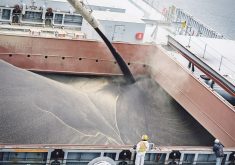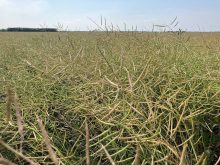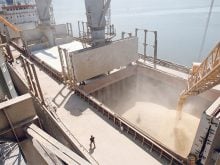Market jumps higher
Fed cattle prices jumped $13-$14 per hundredweight last week thanks in part to the disciplined marketing initiative.
The weekly average on steers was about $93, but the average Oct. 22 and 23 was $1 higher.
Canfax said the highs for the week were impressive with live trade at more than $97, up $11 from the week before and dressed trade at $158, up about $14.
Prices Oct. 23 were steers $89.25-$95.85 per cwt., flat rail $151.75-$156.15 and heifers $89.50-$94.50, flat rail $151.75.
Canfax said the key to the fed market over the next few weeks will be the number of cattle offered for sale and how well the DMI group succeeds.
Read Also

Short rapeseed crop may put China in a bind
Industry thinks China’s rapeseed crop is way smaller than the official government estimate. The country’s canola imports will also be down, so there will be a lot of unmet demand.
Also, the kill must climb from the small Thanksgiving holiday week slaughter of 52,000 head nationally.
Wholesale beef rises
Wholesale carcass prices will have to move higher after last week’s impressive cash cattle gains.
After being absent due to inadequate quotes, Canfax is again including wholesale prices in its report.
Montreal prices were $132-$139 on steers but were expected to be $159-$160 for trade delivered this week.
The Calgary market was $127-$130 but was expected to be $142- $145 this week. Byproduct values were $75-$100 per steer with plant rendering capabilities and offal exports accounting for the differences in the range.
Boxed beef cut-out values in Canada were lower as U.S. beef cut prices dropped and the exchange rate increased.
The U.S. cut-out value was down $14.50-$17 from the previous week’s record high, but was still 57-66 percent higher than a year ago.
Beef exports to the U.S. as of Oct. 20 totalled 75.8 million lb., with Mexico at 2.8 million lb.
Feeders see gains
More cattle went to auction in Alberta with slightly more than 69,000 head trading, up 43 percent from the week before, but down 29 percent from last year.
Premature media speculation on the border reopening in mid-December, as well as stronger fed cattle prices, fuelled the feeder market.
Feeder steers less than 600 lb. traded $8-$8.75 higher than the week before and those heavier than 600 lb. were $1-$2.75 stronger, said Canfax.
The steer prices were $1.75-$8 lower than a year ago.
Feeder heifers were also strong with 500-600 lb. heifers leading the pack averaging $6.50 per cwt. higher.
Other feeder heifer weight classes increased $1.75-$4.50 over last week.
Heifer prices were $5.75-$9.25 lower than last year.
D1, 2 cows were down $2.50 on light trade.
Canfax said the stronger prices should pull more calves to market.
The feeder run normally has begun by this time, but since May 20, most marketings have been delayed by 30-60 days while producers wait to make marketing decisions.
If the stronger fed market price can be sustained in the coming weeks, it will help to support the feeder market and encourage feedlots to place more cattle.
In stock trade, bred cows were $500-$850 and bred heifers were $750-$950. A few cow-calf pairs traded at $700-$900.
Pork prices dip
Wholesale prices for most pork primal cuts dropped again in the U.S., lowering the pork cut-out value by almost $7 US per cwt. from the previous week.
The market responded to increased hog slaughter and lower beef prices, said Manitoba Agriculture.
Hog prices fell as the week progressed.
The Iowa-Minnesota daily direct hog price (plant mean, 51-52 percent, lean carcass converted to live weight) fell from $40.28 per cwt. Oct. 20 to $37.11 Oct. 23.
On average, the week’s hog price was down by five percent from the week before. The Canadian price fell by 1-2 percent.
Manitoba slaughter plants killed almost 72,000 hogs during the holiday-shortened week.














